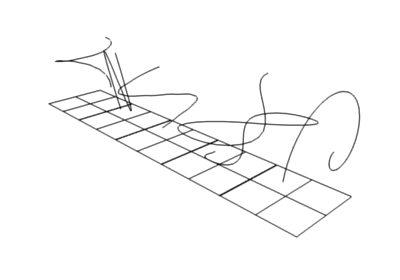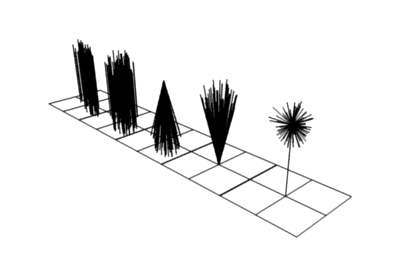Crianças¶
Referência
- Panel:
Children are Hair or Emitter particles originating from individual particles. They make it possible to work primarily with a relatively low amount of Parent particles, for whom the physics are calculated. The children are then aligned to their parents. The number and visualization of the children can be changed without a recalculation of the physics.
If you activate children, the parents are no longer rendered. This can be enabled in the Render panel Parent Particles. By default, parent particles are not rendered because the shape of the children can be quite different from that of their parents.
Opções comuns¶
- Tipo de criança
- Nenhum
No children are generated.
- Simple
Children are emitted from the parent position.
- Interpolated
Children are emitted between the Parent particles on the faces of a mesh. They interpolate between adjacent parents. This is especially useful for fur, because you can achieve an even distribution. Some of the children can become virtual parents, which are influencing other particles nearby.
- Display Amount
The number of children in the 3D Viewport.
- Render Amount
The number of children to be rendered.
- Length
Comprimento dos caminhos das crianças.
- Ajuste
Quantidade de partículas que são deixadas sem toque pelo comprimento do caminho de crianças.
- Semente
Deslocamento dentro de uma tabela de números aleatórios para as partículas crianças, para obter um resultado diferentemente aleatorizado.
Aglomerações¶
Referência
- Panel:
- Usar curvas para formar feixes
Use Assistente de curvas instead of parameters.
- Clump
Clumping amount along child strands. The children may meet at their tip (1.0) or start together at their root (-1.0).
- Shape
Form of Clump. Either inverse parabolic (0.99) or exponentially (-0.99).
- Torção
A ser feito.
- Use Twist Curve
A ser feito.
Clump Noise¶
Creates random clumps around the parent hair.
- Clump Noise Size
The size of the clumps.
Rugosidade¶
Referência
- Panel:
- Usar curva de rugosidade
Use Assistente de curvas instead of parameters.
- Uniform, Size
It is based on children location so it varies the paths in a similar way when the children are near.
- Endpoint, Shape
«Rough End» randomizes path ends (a bit like random negative clumping). Shape may be varied from <1 (parabolic) to 10.0 (hyperbolic).
- Random, Size, Threshold
It is based on a random vector so it is not the same for nearby children. The threshold can be specified to apply this to only a part of children. This is useful for creating a few stray children that will not do what others do.
Kink¶
Referência
- Panel:

Child particles with Kink.¶
From left to right: Curl, Radial, Wave, Braid, Spiral.
With Kink you can rotate the children around the parent. See Fig. Child particles with Kink. above picture for the different types of Kink.
- Kink Type
- Nenhum
Desativado.
- Encaracolar
Children grow in a spiral around the parent hairs.
- Radial
Children form around the parent a wave shape that passes through the parent hair.
- Ondas
Children form a wave, all in the same direction.
- Trançar
Children braid themselves around the parent hair.
- Espiral
Generates a spiral at the end of each hair.
- Raio, Resolução
Define the overall size.
- Shape
Makes the spiral grow in- or outward.
Nota
Limitações de alinhamento
When hair is pointing straight up (along the chosen spiral axis, default Z), spirals may not show up! This is a limitation of the projection method used. Giving a slight tilt or random orientation to hairs fixes this.
- Amplitude
A amplitude do deslocamento.
- Clump
Define quanto o agrupamento afeta a amplitude de torção.
- Nivelamento
Define quão lisos os cabelos são.
- Frequência
The frequency of the offset (1/total length). The higher the frequency the more rotations are done.
- Shape
Where the rotation starts (offset of rotation).
Simple¶
- Tamanho
A multiplier for children size.
- Random Size
Variação aleatória para o tamanho das partículas crianças.
- Raio
The radius in which the children are distributed around their parents. This is 3D, so children may be emitted higher or lower than their parents.
- Circularidade
The roundness of the children around their parents. Either in a sphere (1.0) or in-plane (0.0).
Interpolated¶
- Virtual Parents
Quantidade de parentes virtuais relacionados.
- Cabelos longos
Calcula as crianças que vestem bem os cabelos longos.
Parting¶
- Parting
Creates parting in the children based on parent strands.
- Mínimo/Máximo
The minimum/maximum root to tip angle (tip distance/root distance for long hair).
Exemplo¶

From left to right: Round: 0.0, Round: 1.0, Clump: 1.0, Clump: -1.0, Shape: -0.99.¶